Peter J. Kappel: Veteran of the Month | September 2021
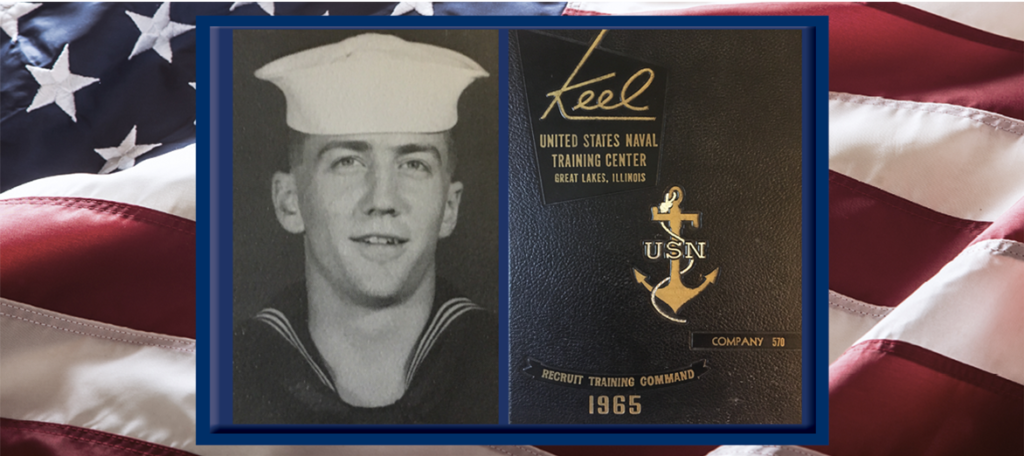
Peter J. Kappel was born in Chicago, July 1947. He was the third child with two older sisters and a younger brother. He lived in Cicero until age 7 or 8 before his family moved to Wisconsin. For three years of grade school, Kappel went to the Redemptorist Seminary, a school of theology, educating in scripture. Growing up, he was interested in “hunting and chasing girls,” he remarked with a chuckle. Towards the end of high school, a friend got him interested in enlisting. Unfortunately, that same friend had an older brother captured and held as a Prisoner of War. This greatly impacted Kappel’s drive to enlist. The last they heard, the brother tried to escape several times, unfortunately not surviving the last attempt. However, Kappel said authorities never verified that information, and he could still be over there today.
Kappel attended basic training at the Great Lakes Naval Base in Chicago for approximately six weeks before receiving orders. He had requested the boiler room, but his company commander saw his request and said, “Son, you are gonna thank me for the rest of your life. You don’t want to be a boilerman.” His advice continued as he instructed Kappel to go out to California and get in the Airdale Flying Squadron. Kappel stated, “The first carrier I was on, I went below deck walking by the hatch where the boilerman worked, and the temperature coming out of there was about 120 degrees and from that day on I was thanking my lucky stars I wasn’t a boilerman.”
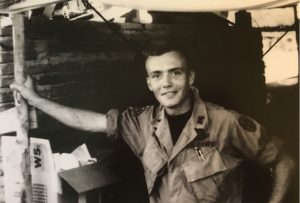
Kappel’s friend, POW/MIA
When Kappel arrived at Lemoore Naval Air Station in Lemoore, CA, he became part of the Airdale Flying Squadron. The term ‘Airdale’ dates back to 1940 and describes naval aviators, flight crewmen, and later, any flight deck crewmen who were part of carrier operations. His squadron worked with the A-4 Skyhawk, a single-seat subsonic, light attack aircraft developed for the U.S. Navy and U.S. Marine Corp. The Blue Angels flew the A-4 Skyhawk from 1974-1986, and they were known as the smallest, lightest attack jets. Kappel’s position in the squadron was plane captain. Navy plane captains serve as the liaison between the pilot and plane and the ground crew, as well as running safety checks and inspections.
During his time in Vietnam, Kappel worked on two different carriers, the USS Coral Sea and the USS Constellation. Kappel did two six-month tours, staying on each carrier non-stop for approximately six months at a time. Kappel explained, “The Coral Sea was a WWII carrier; it was a straight deck they turned into an angled deck.” The USS Coral Sea was also known as the “Ageless Warrior” and was decommissioned by the Navy in 1990. Kappel continued, “The carriers swapped out over there. When one would come online, it would allow us to go back over to Subic Bay to relieve some tensions.” It was in Subic Bay in the Philippines where the carriers would resupply and allow for the crew to get some R & R (rest and relaxation). Kappel explained, “We had our own crews we flew off the carriers. Then you had the airwing, the carriers flight deck crew that shuffled the aircraft on the deck, and then a crew on the hanger bay. We probably had 5000 people on the carrier.” He went on to say, “It was like a mobile city.” There were typically two carriers online, offshore, throughout Vietnam.
In January of 1968, the USS Pueblo, a Navy intelligence vessel, was captured in North Korea. Kappel’s carrier was sent to North Korea as part of a military build-up in the area by the United States. Kappel remembers, “We were due to come home when the Pueblo was captured, so they sent us there instead of going home to show our presence.” He went on to explain, “We received a couple of unit citations for helping the USS Pueblo and another one for what we did in Vietnam.” The Secretary of the Navy awards a unit citation to any Navy or Marine Corps unit, which has distinguished itself under combat or non-combat conditions by either valorous or meritorious achievement compared to other units performing similar service. In 1968 Kappel was honorably discharged as a Seaman E-3.
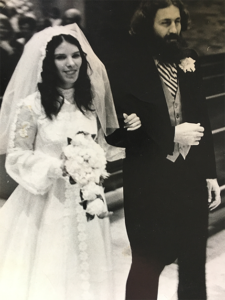
Peter and Annie Kappel September 1973
After returning home, Kappel worked for the Harnischfeger Corporation, building cranes and then at BF Goodridge before looking at the airport in Milwaukee. He was hired on the spot by TWA and sent to Chicago since there wasn’t anything available at the Milwaukee airport. While living in Chicago for work, Kappel would return home to hang with friends whenever he could. Through mutual friends, he met his wife, Annie. They believe it was a setup when they went to the airport to give someone a ride home. The plane was delayed, and they waited all night at the airport bar. Annie said, “One night of drinking at the airport, and that was it!” Annie explained she knew he was the one because she had a premonition of her future husband. She was dreaming one night when right before waking, a man’s face appeared. Annie was dating someone else at the time and said her first thought was, “Who the heck was that?” Later, when she met Kappel, she knew it was the face from her dream, and he was supposed to be with her. Annie’s mom had been praying she would meet a good man, and she told her mom she must’ve been praying too hard. She went on to say, “We went out in January, got engaged in April, and married in September. I just knew and had no questions about it whatsoever!”
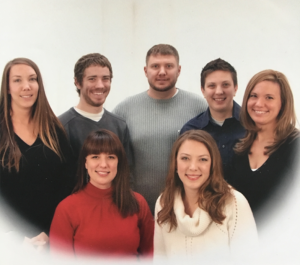
Kappel children
In 1983 TWA transferred the couple to St. Louis, MO. Annie was pregnant with their fifth child at the time. They didn’t know anyone in the area and clung to their TWA family of coworkers. Together they raised seven children, five girls, and two boys.
Two of the Kappel children have also gone into the military. Their daughter Martha has been in the Army Reserves for 12 years and stays with them on free weekends. Their son Peter joined the Navy and even attended basic training at Great Lakes Naval Base in Chicago, just like his father. Kappel said it was a lot of fun going to his graduation and seeing his old naval base, although most of the original buildings were gone by then.
American eventually purchased TWA before Kappel retired in 2005. After over 35 years with the company and a heart attack, Kappel was ready to relax in retirement. He bought his “hot rod,” a 1971 Chevy Nova big block, and enjoys attending car shows. He is also very active in the local VFW, even holding the position of Post Surgeon. He expressed, “There is a lot of stuff I haven’t told the kids or Annie either. There (VFW), you got somebody to talk to. You get to talk things out with other guys that have been in your position and get to be there for guys who have had it worse than you.” He added, “Some of them had it pretty rough too.”
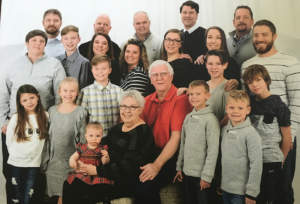
The Kappel family 2019
The Kappel’s have been married for 48 years this month. When I asked them about the date, they said they never remember if it was the 28th or 29th of September. Annie giggled and declared, “As long as we’re still happily married, who cares about the date it happened!” They now have 12 grandchildren and still live in the same house after 39 years. They are happy they raised their family in St. Charles County but would eventually love to get back to Wisconsin.
Veterans Care Coordination is proud to recognize Peter Kappel for his service to our country. We are privileged to have the opportunity to share the stories of our nation’s heroes. Thank you for your service, Peter Kappel, and welcome home.
